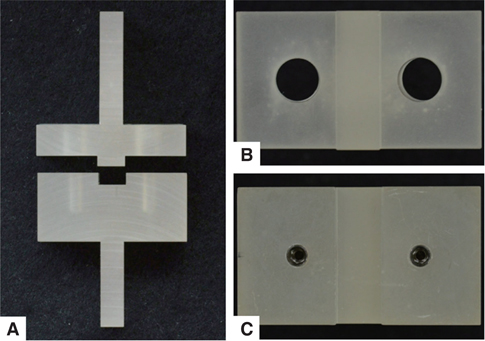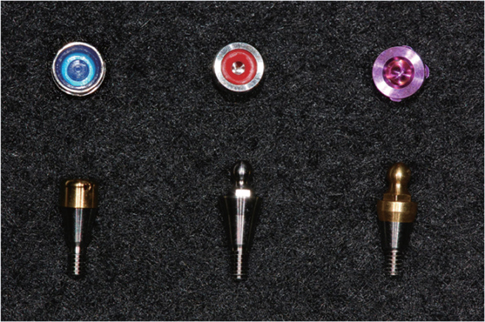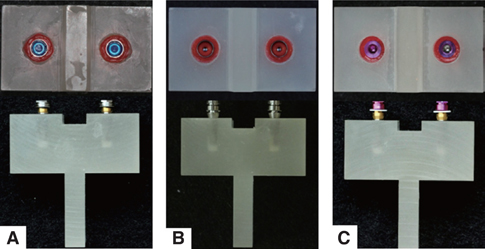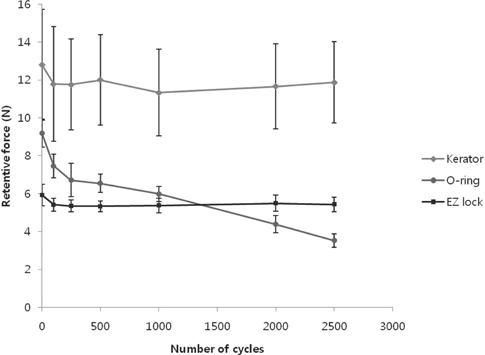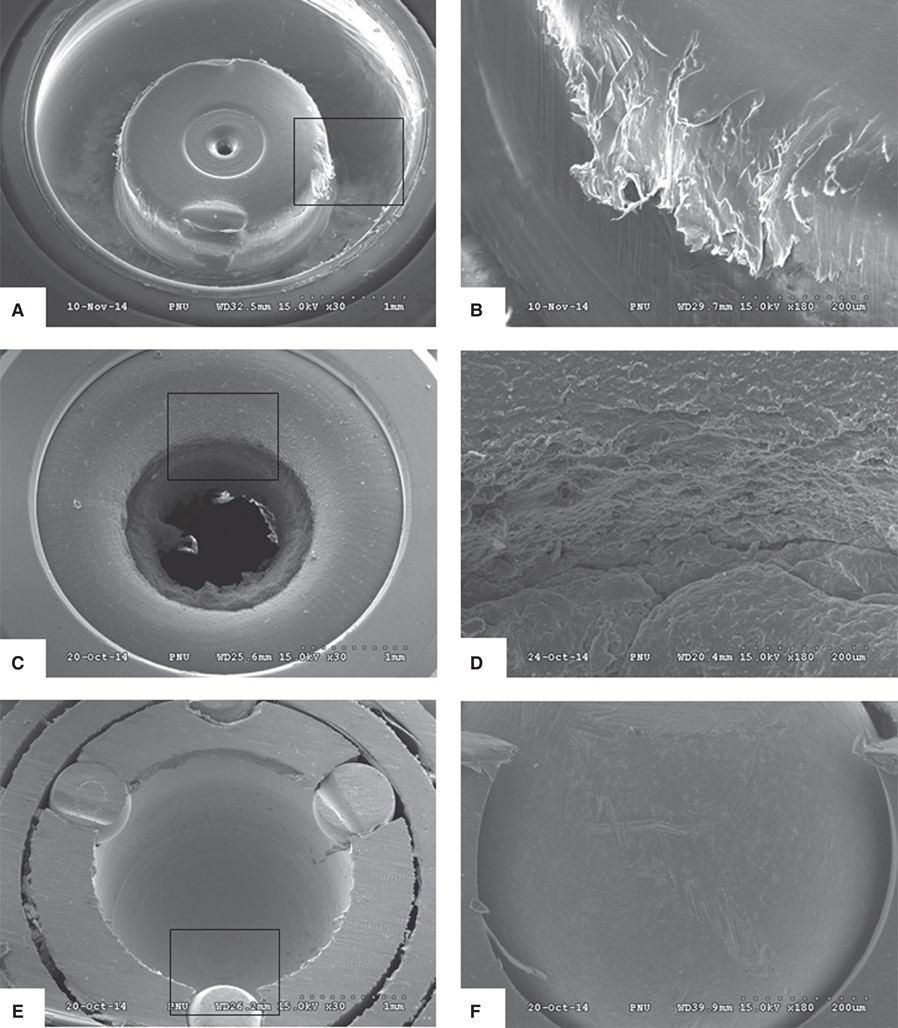J Adv Prosthodont.
2015 Aug;7(4):303-311. 10.4047/jap.2015.7.4.303.
Comparison of changes in retentive force of three stud attachments for implant overdentures
- Affiliations
-
- 1Department of Prosthodontics, School of Dentistry, Pusan National University, Yangsan, Republic of Korea. huhjb@pusan.ac.kr
- KMID: 2118266
- DOI: http://doi.org/10.4047/jap.2015.7.4.303
Abstract
- PURPOSE
The aim of this study was to compare the changes in retentive force of stud attachments for implant overdentures by in vitro 2-year-wear simulation.
MATERIALS AND METHODS
Three commercially available attachment systems were investigated: Kerator blue, O-ring red, and EZ lock. Two implant fixtures were embedded in parallel in each custom base mounting. Five pairs of each attachment system were tested. A universal testing machine was used to measure the retentive force during 2500 insertion and removal cycles. Surface changes on the components were evaluated by scanning electron microscopy (SEM). A Kruskal-Wallis test, followed by Pairwise comparison, was used to compare the retentive force between the groups, and to determine groups that were significantly different (alpha<.05).
RESULTS
A comparison of the initial retentive force revealed the highest value for Kerator, followed by the O-ring and EZ lock attachments. However, no significant difference was detected between Kerator and O-ring (P>.05). After 2500 insertion and removal cycles, the highest retention loss was recorded for O-ring, and no significant difference between Kerator and EZ lock (P>.05). Also, Kerator showed the highest retentive force, followed by EZ lock and O-ring, after 2500 cycles (P<.05). Based on SEM analysis, the polymeric components in O-ring and Kerator were observed to exhibit surface wear and deformation.
CONCLUSION
After 2500 insertion and removal cycles, all attachments exhibited significant loss in retention. Mechanism of retention loss can only be partially explained by surface changes.
Figure
Reference
-
1. Gunne HS, Bergman B, Enbom L, Högström J. Masticatory efficiency of complete denture patients. A clinical examination of potential changes at the transition from old to new denture. Acta Odontol Scand. 1982; 40:289–297.2. Bergman B, Carlsson GE. Clinical long-term study of complete denture wearers. J Prosthet Dent. 1985; 53:56–61.3. van Waas MA. The influence of clinical variables on patients' satisfaction with complete dentures. J Prosthet Dent. 1990; 63:307–310.4. Zitzmann NU, Marinello CP. A review of clinical and technical considerations for fixed and removable implant prostheses in the edentulous mandible. Int J Prosthodont. 2002; 15:65–72.5. Adell R, Eriksson B, Lekholm U, Brånemark PI, Jemt T. Long-term follow-up study of osseointegrated implants in the treatment of totally edentulous jaws. Int J Oral Maxillofac Implants. 1990; 5:347–359.6. Albrektsson T, Zarb G, Worthington P, Eriksson AR. The long-term efficacy of currently used dental implants: a review and proposed criteria of success. Int J Oral Maxillofac Implants. 1986; 1:11–25.7. Petropoulos VC, Smith W. Maximum dislodging forces of implant overdenture stud attachments. Int J Oral Maxillofac Implants. 2002; 17:526–535.8. Misch CE. Contemporary implant dentistry. 2nd ed. Missouri: CV Mosby;1999. p. 67–72.9. Caldwell CW, Clark AE. Dental implant prosthodontics. Philadelphia: JB Lipponeott Co.;1991. p. 313.10. Feine JS, Carlsson GE, Awad MA, Chehade A, Duncan WJ, Gizani S, Head T, Lund JP, MacEntee M, Mericske-Stern R, Mojon P, Morais J, Naert I, Payne AG, Penrod J, Stoker GT, Tawse-Smith A, Taylor TD, Thomason JM, Thomson WM, Wismeijer D. The McGill consensus statement on overdentures. Mandibular two-implant overdentures as first choice standard of care for edentulous patients. Montreal, Quebec, May 24-25, 2002. Int J Oral Maxillofac Implants. 2002; 17:601–602.11. Haraldson T, Jemt T, Stålblad PA, Lekholm U. Oral function in subjects with overdentures supported by osseointegrated implants. Scand J Dent Res. 1988; 96:235–242.12. Melas F, Marcenes W, Wright PS. Oral health impact on daily performance in patients with implant-stabilized overdentures and patients with conventional complete dentures. Int J Oral Maxillofac Implants. 2001; 16:700–712.13. Davis DM. Role of implants in the treatment of edentulous patients. Int J Prosthodont. 1990; 3:42–50.14. Raghoebar GM, Meijer HJ, van't Hof M, Stegenga B, Vissink A. A randomized prospective clinical trial on the effectiveness of three treatment modalities for patients with lower denture problems. A 10 year follow-up study on patient satisfaction. Int J Oral Maxillofac Surg. 2003; 32:498–503.15. Trakas T, Michalakis K, Kang K, Hirayama H. Attachment systems for implant retained overdentures: a literature review. Implant Dent. 2006; 15:24–34.16. Naert I, Gizani S, Vuylsteke M, van Steenberghe D. A 5-year randomized clinical trial on the influence of splinted and unsplinted oral implants in the mandibular overdenture therapy. Part I: Peri-implant outcome. Clin Oral Implants Res. 1998; 9:170–177.17. van Kampen F, Cune M, van der Bilt A, Bosman F. Retention and postinsertion maintenance of bar-clip, ball and magnet attachments in mandibular implant overdenture treatment: an in vivo comparison after 3 months of function. Clin Oral Implants Res. 2003; 14:720–726.18. Cardoso RC, Gerngross PJ, Dominici JT, Kiat-amnuay S. Survey of currently selected dental implants and restorations by prosthodontists. Int J Oral Maxillofac Implants. 2013; 28:1017–1025.19. Goodacre CJ, Bernal G, Rungcharassaeng K, Kan JY. Clinical complications with implants and implant prostheses. J Prosthet Dent. 2003; 90:121–132.20. Walton JN, Ruse ND. In vitro changes in clips and bars used to retain implant overdentures. J Prosthet Dent. 1995; 74:482–486.21. Besimo CH, Graber G, Flühler M. Retention force changes in implant-supported titanium telescope crowns over long-term use in vitro. J Oral Rehabil. 1996; 23:372–378.22. Wichmann MG, Kuntze W. Wear behavior of precision attachments. Int J Prosthodont. 1999; 12:409–414.23. Bayer S, Steinheuser D, Grüner M, Keilig L, Enkling N, Stark H, Mues S. Comparative study of four retentive anchor systems for implant supported overdentures--retention force changes. Gerodontology. 2009; 26:268–272.24. Alsabeeha NH, Payne AG, Swain MV. Attachment systems for mandibular two-implant overdentures: a review of in vitro investigations on retention and wear features. Int J Prosthodont. 2009; 22:429–440.25. Sinclair PM, Little RM. Maturation of untreated normal occlusions. Am J Orthod. 1983; 83:114–123.26. Stephens GJ, di Vitale N, O'Sullivan E, McDonald A. The influence of interimplant divergence on the retention characteristics of locator attachments, a laboratory study. J Prosthodont. 2014; 23:467–475.27. Lehmann KM, Arnim FV. Studies on the retention forces of snap-on attachments. Quintes Dent Technol. 1978; 7:45–48.28. Setz I, Lee SH, Engel E. Retention of prefabricated attachments for implant stabilized overdentures in the edentulous mandible: an in vitro study. J Prosthet Dent. 1998; 80:323–329.29. Pigozzo MN, Mesquita MF, Henriques GE, Vaz LG. The service life of implant-retained overdenture attachment systems. J Prosthet Dent. 2009; 102:74–80.30. Alsabeeha NH, Swain MV, Payne AG. Clinical performance and material properties of single-implant overdenture attachment systems. Int J Prosthodont. 2011; 24:247–254.31. Rutkunas V, Mizutani H, Takahashi H, Iwasaki N. Wear simulation effects on overdenture stud attachments. Dent Mater J. 2011; 11. 25.32. Schallamach A. A theory of dynamic rubber friction. Wear. 1963; 6:375–382.33. Nagaoka E, Nagayasu Y, Yamashita H, Matsushiro H, Okuno Y. Study of retention in attachments for overdenture. (II) O-ring attachment. J Osaka Univ Dent Sch. 1980; 20:215–226.34. Gent AN, Pulford CTR. Wear of metal by rubber. J Mater Sci. 1979; 14:1301–1307.35. Winkler S, Piermatti J, Rothman A, Siamos G. An overview of the O-ring implant overdenture attachment: clinical reports. J Oral Implantol. 2002; 28:82–86.36. Gamborena JI, Hazelton LR, NaBadalung D, Brudvik J. Retention of ERA direct overdenture attachments before and after fatigue loading. Int J Prosthodont. 1997; 10:123–130.37. Mezger PR, Creugers NH. Titanium nitride coatings in clinical dentistry. J Dent. 1992; 20:342–344.38. Halling J. Introduction to Tribology. 5th ed. London: Wykham Publications;1976. p. 63–82.39. Williams BH, Ochiai KT, Hojo S, Nishimura R, Caputo AA. Retention of maxillary implant overdenture bars of different designs. J Prosthet Dent. 2001; 86:603–607.
- Full Text Links
- Actions
-
Cited
- CITED
-
- Close
- Share
- Similar articles
-
- A Study on the Retentive Force of Stud Attachments for Implant Overdenture
- Comparative studies of retentive forces in maxillary overdenture bar attachments
- Overdentures using newly designed metal ball attachment containing predetermined gap with stress breakers
- Comparison of the retentive characteristics of two additional attachment used with an implant bar attachment
- Clinical evaluation of implant retained overdentures using two implant and Locator attachments in the fully edentulous mandibles

